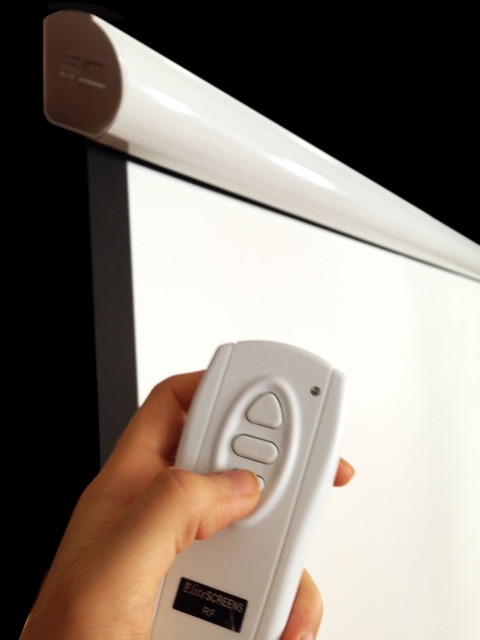PHYSICAL CONSTRUCTION
Excellent. It’s durable, thoughtfully designed, and a great complement to the decor of any room. The screen fabric is high quality, and in turn, the projected image picture is flawless. From static data to HD video, the imagery on the screen is extremely bright with light evenly dispersed in both the horizontal and vertical planes. “Perceived quality” and contrast ratio are excellent, as is on-screen color rendition. The roller mechanism works reliably and quietly. The roller’s housing is also a nice shade of white — it is not too bright, glossy, or shiny. It’s a subdued white that blends into any wall. Allied trades like interior decorators and architects will appreciate the attention to detail. When the screen is recessed it disappears into the decor.
INPUTS/OUTPUTS/CONTROLS
Excellent. I like that you can unplug the cord so that there doesn’t have to be any visible cord or wall box. It’s easy to pop out if you want. It offers a 12-Volt trigger which can connect to the projector, and an IR eye receiver for more remote control options. The wall box is powerful and makes sense—feature-wise—but I would prefer if it were a little smaller, for concealment purposes. A more complex wiring option available with the PowerMax Pro allows you to tie the screen into your building control system for even more seamless operation. It’s a great option.
TECHNICIAN-LEVEL USER-FRIENDLINESS
Excellent. It took me 15 minutes to install this screen. It would take a team of two people half that time. The PowerMax Pro is a solid choice for both seasoned systems integrators and in-house tech managers that want to do their own installation. The screen can be mounted in two ways—flush mounted on the wall or hanging from the ceiling. For such a large viewing area, the screen is surprisingly lightweight; regardless of technical ability or physical strength of the technician, anyone on your team can securely mount this screen. It’s easy to handle overhead, high on a ladder, et cetera. The fix plate design for the roller, the loop holes for mounting, and screen construction allow for creative mounting possibilities. The clips that will hold the roller along the wall don’t have to be anchored at specific points on the wall or ceiling; therefore they can be anywhere you like. If you’re trying to avoid specific places—like a smoke detector, framed art, wood moldings, or a thermostat—you have that option. As long as it’s level, it will work. If you cannot mount it to the ceiling or wall (e.g., you have crafted tin ceilings in a historic building) you can easily hang it from the included suspended ceiling brackets. Ceiling chains are not included, but I didn’t need them for my install. Once the screen is mounted, and you just want to use the IR and three-way wall switch, there is no wiring involved. Just plug in the cord and it’s good to go. Again, you have the option of tying this into your facility’s control system, which expands your possibilities.
EASE OF USE (END-USER)
Excellent. It’s extremely user-friendly for everyone. All you have to do is—quite literally—press one button. Anyone in the facility can operate this with confidence; it’s easier than operating a TV remote. Since it is not a manual pull-down, its functionality extends to all users, regardless of their mobility. For a facility that just wants plug-and-play operation from a motorized screen, this definitely delivers.
WARRANTY AND PRICING
“The PowerMax Pro has pricing as low as $903 (U.S.) MSRP and is part of the Elite Prime Vision (EPV) line of protected, CI/Pro AV-exclusive projection screens. Each comes with a full three-year warranty.” (Source: EliteScreens.com)
Absolutely. You get a major return on the investment because my value equation includes the day-to-day ease of use, 10-minute installation, no need to “train” facility managers and users, the lack of upkeep (it’s remarkably dust-resistant). You set it and forget it—it’s technology that does not get in the way.
Margot Douaihy is the editor of AV Technology and EduWire.com.











